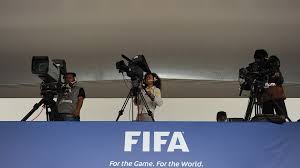By David Owen
March 18 – The full scale of the financial damage wreaked by FIFA’s year of turmoil is now becoming apparent. Revenue from marketing rights to the World Cup – sponsorship to you and me – is down over $100 million, or 29%, in 2015 from the equivalent figure in 2011, the corresponding point in the previous four-year commercial cycle.
Interestingly, the carnage has not come at the FIFA Partnership level, the top tier, even though the world body has one fewer such sponsor in 2015 – five – than the half-dozen on board four years ago.
Between them, these famous five – Adidas, Coca-Cola, Gazprom, Hyundai/Kia and Visa – contributed exactly $180 million in 2015, compared with $177.125 million chipped in by Adidas, Coca-Cola, Emirates, Hyundai/Kia, Sony and Visa four years earlier.
This contribution remained constant through the subsequent three years running up to and including the Brazil 2014 World Cup. This made for an overall contribution of $708.5 million, or an average of just over $118 million each.
Assuming the current five FIFA Partners similarly pay $180 million per annum right through to Russia 2018, this would make for an average of $144 million each – in effect, a 22% uplift in the ticket price for top-tier FIFA sponsorship. (It is not known whether each individual FIFA Partner does in fact pay the same amount to belong to the programme.)
The picture turns bleak for FIFA only when scrutinising the sums raised from lower sponsorship levels. The FIFA World Cup sponsors category contributed only $44.5 million in 2015. This compared with $130.8 million in 2011 – an annual total that was broadly maintained all the way through to Brazil 2014. Companies falling into this category then included the likes of Budweiser, Continental and Yingli Solar.
The national supporters category generated a big fat zero in 2015, compared with $28.6 million in 2011 – a total that increased to more than $40 million in each of the next three years. National supporters of Brazil 2014 included Apex-Brasil, Itaú and Liberty Seguros.
The new regime at FIFA will now be looking to Russian companies to step in and at least match the $164 million contributed between 2011 and 2014 by these national supporters between now and the crowning of the new world champions in 2018.
By contrast, FIFA’s revenue from television broadcasting rights – its largest single income source – registered a substantial increase in 2015 compared with four years earlier. This underlines how the reputation of the body’s flagship tournament has emerged largely unscathed from the crisis, something that may yet prove FIFA’s salvation.
Revenue from this source amounted to $628.5 million last year, up from $550.3 million in 2011. The most impressive advance – from $61.2 million to $130.2 million – was registered in North America and the Caribbean, perhaps reflecting the sport’s growing popularity in the United States.
South/Central America and Asia and North Africa also made significantly increased contributions. The sum generated from Europe, by contrast, fell by almost exactly $100 million, from $281.1 million in 2011 to $181.2 million last year.
Contact the writer of this story at moc.l1714409691labto1714409691ofdlr1714409691owedi1714409691sni@n1714409691ewo.d1714409691ivad1714409691

